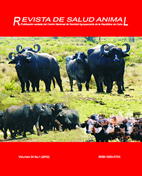Ornithobacterium rhinotracheale BIOFILM FORMATION IN ABIOTIC SURFACE
Contenido principal del artículo
Resumen
Although there is a large amount of data and information about pathogens, commensal and environmental bacteria came from the study of planktonic growth. It is now clear that bacteria in the tissues and/or environment live more as communities of microorganisms surrounded by an extracellular polymeric matrix (biofilms) than as single cell suspensions. Many biofilm infections are difficult to solve and they commonly are manifested as chronic or recurrent infections because of microorganisms growing as biofilms are significantly less susceptible to antibiotics and host defenses than planktonic forms.
Recently, our group researched the ability Ornithobacterium rhinotracheale to produce biofilms in abiotic surface. Results showed statistical differences in biofilm formation among nine Cuban isolates of unknow serotype incubated in polystyrene plates during 48 h; however all were moderate biofilm producer. The inoculation in borosilicate tubes
This new highlight aspect increases knowledge on this bacterium and its potential to develop latent infections that could be a critical point in the pathogenesis, epidemiology and control programme of avian respiratory diseases.
Recently, our group researched the ability Ornithobacterium rhinotracheale to produce biofilms in abiotic surface. Results showed statistical differences in biofilm formation among nine Cuban isolates of unknow serotype incubated in polystyrene plates during 48 h; however all were moderate biofilm producer. The inoculation in borosilicate tubes
This new highlight aspect increases knowledge on this bacterium and its potential to develop latent infections that could be a critical point in the pathogenesis, epidemiology and control programme of avian respiratory diseases.
Detalles del artículo
Cómo citar
1.
Vichi J, Hernández M, Espinosa I, Báez M, Martínez S. Ornithobacterium rhinotracheale BIOFILM FORMATION IN ABIOTIC SURFACE. Rev. Salud Anim. [Internet]. 22 de mayo de 2013 [citado 23 de noviembre de 2025];34(1):65. Disponible en: https://revistas.censa.edu.cu/index.php/RSA/article/view/77
Número
Sección
CARTAS AL EDITOR
Aquellos autores/as que tengan publicaciones con esta revista, aceptan los términos siguientes:
- Los autores/as conservarán sus derechos de autor y garantizarán a la revista el derecho de primera publicación de su obra, el cual estará simultáneamente sujeto a la Licencia Creative Commons Attribution-NonCommercial 4.0 International (CC BY-NC 4.0) que prohíbe el uso comercial de sus publicaciones y permite a terceros compartir la obra siempre que se indique su autor y la primera publicación en esta revista. Bajo esta licencia el autor será libre de:
- Compartir — copiar y redistribuir el material en cualquier medio o formato
- Adaptar — remezclar, transformar y crear a partir del material
- El licenciador no puede revocar estas libertades mientras cumpla con los términos de la licencia
Bajo las siguientes condiciones:
- Reconocimiento — Debe reconocer adecuadamente la autoría, proporcionar un enlace a la licencia e indicar si se han realizado cambios. Puede hacerlo de cualquier manera razonable, pero no de una manera que sugiera que tiene el apoyo del licenciador o lo recibe por el uso que hace.
- NoComercial — No puede utilizar el material para una finalidad comercial.
- No hay restricciones adicionales — No puede aplicar términos legales o medidas tecnológicas que legalmente restrinjan realizar aquello que la licencia permite.
- Los autores/as podrán adoptar otros acuerdos de licencia no exclusiva de distribución de la versión de la obra publicada (p. ej.: depositarla en un archivo telemático institucional o publicarla en un volumen monográfico) siempre que se indique la publicación inicial en esta revista.
- Se permite y recomienda a los autores/as difundir su obra a través de Internet (p. ej.: en archivos telemáticos institucionales o en su página web) antes y durante el proceso de envío, lo cual puede producir intercambios interesantes y aumentar las citas de la obra publicada. (Véase El efecto del acceso abierto).
